
[From Handbook En Route, 1899]

" The wandering rover, who all the world over,
From country to country, has been,
Can discover nowhere with thee to compare,
O Vannin Veg Villish Veen!"
(" WANDESCOPE "-MANX SONG.)
 o breathe again the pure air," that is to visit Manxland-a climate at once
the most temperate and the most bracing in the world. The commonest scenes of field and hill derive an added charm from
the purity of the atmosphere, a blending of the air of mountain and sea. It is a land of legendary lore, romance, song and
humour. For the artist, in landscape and seascape there is a perfect brilliancy of colour-on harbour and hill, the sun setting
on castles by the sea, and the red sails of fishermen on the horizon of the west.
o breathe again the pure air," that is to visit Manxland-a climate at once
the most temperate and the most bracing in the world. The commonest scenes of field and hill derive an added charm from
the purity of the atmosphere, a blending of the air of mountain and sea. It is a land of legendary lore, romance, song and
humour. For the artist, in landscape and seascape there is a perfect brilliancy of colour-on harbour and hill, the sun setting
on castles by the sea, and the red sails of fishermen on the horizon of the west.
Manx life is touched still with the glamour, it has still the form, of olden times. The people are a blend of Celtic and Scandinavian. The Norse tongue has left its traces in local names ; the Celtic in vernacular speech. The people in the south are more Celtic, more smooth-spoken and of average mould. In the north more Scandinavian, of finer than average figure, broad in speech, brusque in manner, with all the qualities that wear best. In the north are found most choice types of manhood and woman-hood, the distinctive physique and beauty of the Manx race.
There are seven routes to the Island. The principal in summer, and the only daily service in winter, is from Liverpool to Douglas. The Isle of Man Steam Packet Company was founded in 1830 ; their first boat was 105 feet long and of 100 h.p. The last addition to their now magnificent fleet of twelve steamers is the " Empress-Queen," 385 feet long and of 10,000 h.p., the fastest paddle-boat afloat. The passage is 3½ hours---a mere luxurious sail. Of all cross-channel services these boats have the highest record for certainty and safety.
Approaching the Island one sees grey walls of cliff emerge from the waters with undulating purple mountains inland. Douglas rises like a fabled city lined out on the horizon of throbbing waves. As the distance lessens the fine aspect of the town is displayed in detail, underlined by a continuous riband of shore.
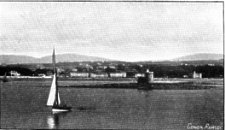
DOUGLAS BAY
Douglas from the sea is incomparable. The Bay has been compared to the Bay of Naples and to Dublin Bay. It is smaller than either-- deriving its peculiar charm from many picturesque features, combining into a perfectly unique whole, and the central mountains of the Island standing as background in the picture. Douglas has excellent hotels; and boarding- houses that for moderate charges and up-to-date outfit challenge comparison with any watering place in Britain. The sea-front around the Bay is, in fact, a chain of hotels and boarding-houses broken by some conspicuous older mansions. Of these Castle Mona, in the centre, the seat of the Dukes of Athol when Lords of Man, and Derby Castle at the extreme right hand end of the Crescent, are now hotels. The most interesting building in Old Douglas was St. Matthew's Church in the market place, demolished in 1899.
A circular system of cable trams runs from Victoria Pier, by Victoria Street, Prospect Hill, Bucks Road, and along Woodbourne Road-the trunk thoroughfare. It then turns and descends to the Promenade, the circuit being completed by the horse trams which run round the crescent of the Bay from Victoria Pier to Derby Castle. Every part of the town is accessible by this circular system, no locality being far from some point of its circuit. The horse trams have their terminus at Derby Castle, in the station of the Coast and Mountain Electric Railways.
The old mansion of Derby Castle is now a hotel, with concert pavilion in the grounds. The terminus of the Electric Railway fronts on the Promenade. Beyond the Pavilion is the Power Station-one of four : the others being at Laxey, Snaefell, and Ballaglass. This station has three inverted vertical compound engines, each of 90 h. p. , driving Edison - Hopkinson dynamos. At Laxey are two similar engines driving dynamos by belt connection ; and also one 180 h.p. engine coupled direct to a multi- polar dynamo. Between these stations there is at Groudle an accumulator battery holding electrical energy in reserve. The severest gradients on this section of line are 1 in 24. The system on the cars is by trolley-wheel connection with an overhead wire.
Banks Howe is a grassy hill some 500 feet in altitude, a noble bastion of the coast north- east of Douglas Bay, with jagged grey cliffs reaching their highest a mile or so beyond Derby Castle. The finest views in the neighbourhood of Douglas are those from its summit. The Howe was a sheep run; it is now golf links-the electric railway setting down golfers near the top of the gradient, 300 feet above sea-level. There is nothing finer of its kind than the exhilaration of the pure air and breeze on this delightful spot. The prospects in every direction are fine ; but the panorama of Douglas Bay, the town and its environs, is superb. The central mountain range of the Island recedes in echelon south-west and north-east -the principal summits all visible, with Snaefell conspicuous due north. Glimpses are obtainable of twelve of the seventeen parishes. Groudle Glen, descending from the mountains north-west to the base of the Howe, skirts its north side to the sea. Beyond Groudle, north-east, a succession of spurs at once suggest and conceal other glens towards Laxey and Ramsey.
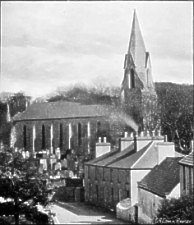
ONCHAN CHURCH
The most pleasant suburb of Douglas is Onchan, landward of Banks Howe -from Conachan or Kentigern (died 901). Steeple and the clump of fine trees around it figure most picturesquely from every point of view. In the tower are preserved some fine Manx crosses dating from the eleventh century, their design indicating Northumbrian influence.
Here we note the characteristics of Manx landscape. The uplands are bare slopes dotted with white farmsteads and fields piped with yellow lines of gorse. Above the cultivated limit is an alternation of grassy fell and heathery moor. The charm of it all is in the free sweep and flight of the eye along the slopes of green to the purple and blue of the mountains. The moors ooze in perennial rills, feeding the rivers that twist down through the mountain glens. Though the hillsides are bare, the glens are beautifully wooded. Silver-grey and golden- boled ash, sycamore, elm, and beech are the most common. Larch and pine plantations are frequent. In the mountain gullies blackthorn and mountain ash.
Gorse abounds everywhere, growing more luxuriantly than even in Brittany or Cornwall. "The colour of the Island," says Mr. Hall Caine, " is green and gold; its odour that of a nut. Both colour and odour come from the gorse." The seaboard of the Island rests on stupendous platforms of cliff. From Banks Howe we trace headlands of jagged slate, between which lie hidden river estuaries, creeks, bays; and crescent bends of strand.
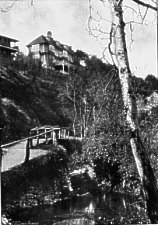
From Derby Castle-the Power Station on the left, and on the right Onchan Harbour and the Mansion, a fine Elizabethan house over-looking the sea-the line sweeps up the seaward side of Banks Howe. Douglas Bay is in panorama behind. On the left are the golf ' links. The top of the gradient -is on the cliffs, 300 feet above the sea, thundering underneath. At the turn the line enters Groudle Glen- anciently h scadala, its harbour Escadala-vik. Across the glen among the fields is - Old Lonan. In its churchyard is the finest purely Celtic cross in Man. Half-a-mile from the sea is Groudle Hotel, on the edge of a ravine beside the Electric Railway viaduct and accumulator battery-house. The coast at Groudle is a good specimen of the Island's jagged sea-walls.
Coan means split or division. Lhen Coan is a miniature canon of great beauty formed by a brook that enters Groudle below the hotel. Paths cut in rock, and footbridges lead to the cool recesses and water-breaks within the canon. The Electric Railway skirts its western side, crossing at the canon head. The belief in fairies is gone, so are the fairies ; but good stories survive. " About sixty, or, for the matter of that, a hundred years ago, in the dusk of a summer's evening, two girls were crossing from Old Lonan to Bibaloe. At Lhen Coan stream they found some little people playing hop, skip, and jump, over the stepping stones. Each of the little people came bounding across with a wild heuch ! One girl shuddered; but the other laughed, and calling out ' Heuch, shin-hene ! ' ('Clear the way yourselves'), bounded with hop, skip, and jump across the river. At the sound of her voice, all the little people instantly vanished."
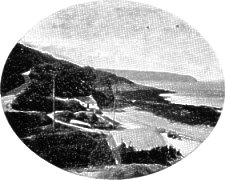
Photo by Cowen, Ramsey.
GARWICK.
Two miles through cultivated fields broken by banks of luxuriant gorse, and over a low divide, the line dips into Garwick-the view opening on Laxey Bay. Above the culvert is a prehistoric fort perched on a knoll of rock encircled by the ravine. Below is a picturesque mill-wheel. Farther down the glen the red-tiled roof of Garwick Hotel, half hidden by woods, marks the entrance to the glen seawards, and a most delightful shore. The old saddle- road crosses the glen by the hotel door : and beside it are the Cloven Stones, the venerable remains of a prehistoric burial cairn. Garwick Bay is properly a corner of Laxey Bay. The coast south-eastwards to Clay Head has lofty cliffs hung with ivy and coast vegetation, the haunt of owl, hawk, and jackdaw. The raven builds on the brows of Clay Head. High up over Laxey Bay is Lonan Church. Beyond it Snaefell is seen in the distance; and on the left Cairn Gerjol (Beacon Cairn).
Between Lonan Church and the cliffs at Kil-Killane, lintel graves or kist vams are visible in the cutting. Their date is at latest the twelfth century. From this point a steep gradient sweeps down to Laxey, with a beautiful little "haven under the hill," on the right.
Old Laxey, overlooked from the line, is on a flat by the estuary of Laxey river. The harbour has on one side shelving rock, on the other a pier of massive rough stone Lax-a is salmon-water. The primitive pack-horse road, impassable for vehicles and of terrific steepness, and the old coach road scarcely less steep, cross the valley by its picturesque bridge. The original bridge was doubtless built by the monks of Rushen, for the Dhoon abbey-lands. Laxey Beach is a lovely roamage in view of the headlands-the sands good bathing ground; the coast safe for boating; and the fishing excellent in the bay and along towards the Dhoon. Kil-Niglus (Church of Nicholas)and its well (Chibbyr-Niglus) are by the saddle- road near the bridge. The street corners of Old Laxey are picturesque. Artists will find good " bits " all about.
Above the whitewashed hamlet of Minorca, overlooking Old Laxey, is an immense pre-historic burial place, consisting of two chambers of huge stones rudely chiselled, commonly called King Orry's Grave-the name a modern figment. The mounds date from long before the Orry Kings, who were buried at Iona, Furness and Rushen Abbeys.
The line turns up the valley towards the mountains. A mile from the sea two deep glens meet at right angles--Glen Roy from Cairn Gerjol west and Laxey from Snaefell north. High road and line cross the debouchure of Glen Roy on lofty parallel bridges, the line to a beautiful pine-shaded terrace overlooking the meeting of the rivers. Glen Roy has its recesses clothed with woods and virgin wilderness. Within its precincts are the Glen Gardens, where art has made a veritable Paradise - arbours, lawns, tennis- grounds, woodland walks, and a vista of wild mountain glen beyond. This river has some fine falls, notably Nikkesen, the locale of weird strange stories handed down from the Norse imagination. The water-breaks and pools are a perfect angler's Eden. The restaurant in the gardens is continental-roofs and verandahs reminiscent of Switzerland and the Rhine; and the ideas of comfort in vogue at those resorts adopted here. Manx homespun from St. George's Mill in Laxey is supplied to the Úlite of the artistic and aesthetic world of London. At Laxey Station is the junction for Snaefell. The ascent is four and three-quarter miles up the south-western side of Great Laxey Valley. The waybed is the perfection of soundness and strength. The cars are of immense power; and the brake systems so strong as to preclude the possibility of accident.
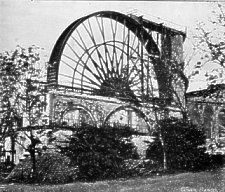
THE BIG WHEEL.
Across the valley is the famous Big Wheel, till quite recently the largest in the world. Its height is 72 feet; breadth 6 feet ; effective power 200 h.p. Water rises through a hollow stone tower, and overflows into its overshot lade, the wheel working as an automatic pump and discharging from 50 to 300 gallons per minute from a shaft 1,200 feet deep.
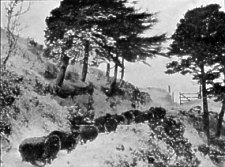
Sheep under snow
On this side of the valley is Raby, the scene of the old Manx song, " Sheep under Snow " (Kirree fo niaghtey), composed by Kelly of Raby when lying in Castle Rushen, his life sworn away by a vindictive woman. Opposite to Raby - over against us are bridge, mill, rushing streams, farmsteads, and white miners' cottages in the foreground ; beyond, the ravine of Glendrink with copses of 24 hazel and gorse ; higher up, the clustered hamlet of Agneash perched on the edge of Glendrink. Soaring skywards in the background the front of Creg Agneash ; and on its heights wild mountain pastures dotted with sheep.
For three miles the line looks down into the yawning canon of Great Laxey Valley, every object dwindled into insignificance-the river a riband of blue, the road a mere white line.
At the head of the valley, against the base of Snaefell, is the Snaefell Mine, famous for the appalling calamity of May 10th, 1897, and for the unavailing heroism of the Snaefell and Laxey miners in the rescue of their comrades. Over this scene Snaefell soars dispassionate.
Just past the Power Station the line reaches the " divide " of the Island, and for a moment is on the level in passing to the western side of the mountain where the final ascent begins. The following statistics will prove interesting and, to the timid passenger, reassuring. The Snaefell Power Station has four Lancashire boilers and five horizontal compound engines, each of 120 h. p. , driving Edison- Hopkinson dynamos. There is also an accumulator battery attached to this station. A constant force of 600 h.p. feeds the flowing stream of energy.
In addition to this, and to the reserve battery, the line is electrically connected with the lower lines so as to draw, if necessary, on the reserve energy accumulated in the other systems. The gradients on the Snaefell ascent are very severe-an almost continuous climb of 1 in 12 for nearly five miles, requiring 100 h.p. per loaded car. As the engines work day and night, the reserve power is always immensely in excess of actual requirements.
From the " divide " the car rises round the western side and the north end of the mountain dome, to the east shoulder 100 feet below the summit. All the way up successive panoramas of valley, moor, mountain, coast and ocean sweep into the line of vision as in a gigantic camera obscura. The summit (2,034 feet) has a rude cairn of slate, and near it the roofless shelter used by the Ordnance Survey in 1865.
South from the cairn is the Mountain Hotel, a delightful refectory. One feels hungry here; and even thirsty. On the Manx mountains there grows a plant, called the " hungry plant," on which if a man sets his foot, he is instantly reminded 0f the contents 0f his knapsack. The hotel has rooms available for those who wish to see a sunrise on Snaefell. All mountain views depend on the atmospheric conditions of the hour. In broken weather the forming and dispersing of clouds can be seen in Nature's own laboratory. There is always a breeze on Snaefell. There is plenty of wind even when the sea far below lies still and calm. England, Scotland, Ireland and Wales are visible-some glimpses Of them even through openings in the driving clouds. The panoramas of the Island, spread out in contour to all the arts of the compass with infinitude of detail, and the colours of sunshine. From the Calf of Man south-west to the Point of Ayre north is all visible in one glance. The ranged peaks trend off in zigzag. The Island seems but a vast ship, the foam on its shores suggesting that it is sailing on.
SHERRAGH VANE.
Due west of Snaefell, on a moorland ridge, is the Sherragh Vane, or White Foal, an immense boulder of quartz giving its name to a moorland farm, the scene of the Rev. T. E. Brown's romantic story "Kitty of the Sherragh Vane."
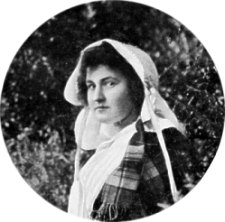
The KITTY OF THE SHERRAGH VANE.
Such a figure,
Such a face, such a look, right at ye-
Rather silent, as you may say,
Silent and thoughtful, and keeping you off-"
" KITTY OF THE SHERRAGH VANE." T. E. Brown.)
The descent is a sensation in itself : the scenes are retraced. Beyond the mountain ridge, north-east, lie Maughold and Ramsey.
Midway down the valley may be noticed a lofty thin cascade descending the opposite hill- side. It is Glen Foss (Norse- -Foss, a waterfall), one of a hundred examples of the Norse language surviving in the names of places and people. Lonan is especially rich in these survivals.
|
|
||
| |
||
|
|
||
|
Any comments, errors or omissions gratefully received
The Editor HTML Transcription © F.Coakley , 2008 |
||